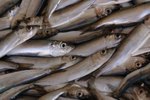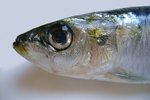Four different basilisk species exist, all belonging to the taxonomic genus Basiliscus. These are the brown or striped basilisk, the green or plumed basilisk, the western or red-head basilisk and the common basilisk. All of these creatures can be found in varying parts of South and Central America. Their ability to run short distances on top of water has earned them the nickname Jesus lizard.
Brown Basilisk Diet
Brown basilisks (Basiliscus vittatus) are primarily insectivores, meaning that insects make up the majority of their diets. As they live near water, they often eat aquatic insects or those with aquatic larvae, whose adults will emerge near water. They also commonly eat grasshoppers and scorpions. However, they're technically omnivores and are opportunistic eaters, so you'll also find them snacking on fruits, berries, freshwater shrimp and various small lizards and snakes.
Green Basilisk Diet
Although they're primarily carnivorous, Green basilisks (Basiliscus plumifrons) -- also known as plumed basilisks -- are considered to be omnivores as they can eat a range of animal and plant foods. Their wild diet consists of various plants, fruits, insects and small vertebrates. Since they live close to water, frogs and smaller types of fish are commonly on the menu.
Western Basilisk Diet
Like other basilisks, western -- or red-head -- basilisks (Basiliscus galeritus) are omnivorous lizards. Insects make up a large part of their diets, but they may also hunt for fish, small vertebrates and non-insect arthropods. In addition, they forage for various types of plant matter, but mainly fruits and seeds.
Common Basilisk Diet
Although common basilisks (Basiliscus basiliscus) are omnivorous, a study of those lizards living in Panama showed that they favor meaty foods, with their diets comprising of 22 percent plant matter and 78 percent animal matter. However, it's unclear if this rings true for all populations. Their diets include insects, non-insect arthropods, fish, flowers, fruits, freshwater shrimp, small mammals, birds and reptiles. Juveniles of the species are primarily insectivorous, becoming more herbivorous with age.





